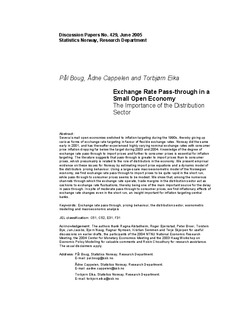Exchange rate pass-through in a Small Open Economy
Working paper

Åpne
Permanent lenke
http://hdl.handle.net/11250/180145Utgivelsesdato
2005Metadata
Vis full innførselSamlinger
- Discussion Papers [1002]
Sammendrag
Abstract:
Several small open economies switched to inflation targeting during the 1990s, thereby giving up
various forms of exchange rate targeting in favour of flexible exchange rates. Norway did the same
early in 2001, and has thereafter experienced highly varying nominal exchange rates with consumer
price inflation dropping far below the target during 2003 and 2004. Knowledge of the degree of
exchange rate pass-through to import prices and further to consumer prices is essential for inflation
targeting. The literature suggests that pass-through is greater to import prices than to consumer
prices, which presumably is related to the role of distributors in the economy. We present empirical
evidence on these issues for Norway by estimating import price equations and a dynamic model of
the distributors pricing behaviour. Using a large-scale macroeconometric model of the Norwegian
economy, we find exchange rate pass-through to import prices to be quite rapid in the short run,
while pass-through to consumer prices seems to be modest. We show that, among the numerous
channels through which the exchange rate operate, trade margins in the distribution sector act as
cushions to exchange rate fluctuations, thereby being one of the main important source for the delay
in pass-through. In spite of moderate pass-through to consumer prices, we find inflationary effects of
exchange rate changes even in the short run, an insight important for inflation targeting central
banks.
Keywords: Exchange rate pass-through, pricing behaviour, the distribution sector, econometric
modelling and macroeconomic analysis